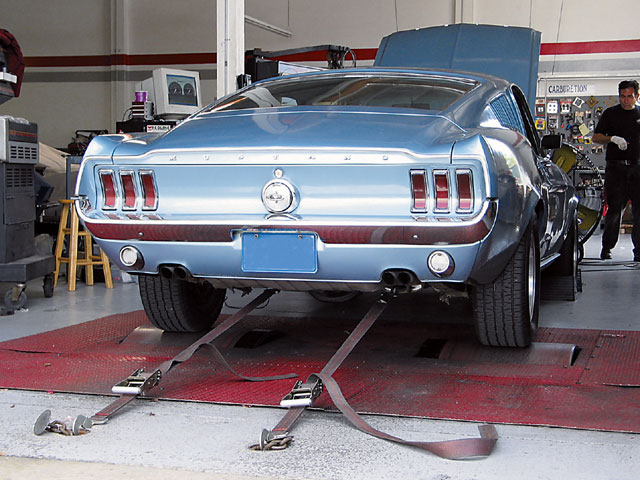Chassis Dyno

A chassis dynamometer measures power delivered to the surface of the "drive roller" by the drive wheels. The vehicle is often parked on the roller or rollers, which the car then turns and the output is measured. Modern roller type chassis dyne systems use the Salvisberg roller, which improved traction and repeatability over smooth or knurled drive rollers.
On a motorcycle, typical power loss at higher power levels, mostly through tire flex, is about 10% and gearbox chain and other power transferring parts are another 2% to 5%. Other types of chassis dynamometers are available that eliminate the potential wheel slippage on old style drive rollers and attach directly to the vehicle's hubs for direct torque measurement from the axle. Hub mounted dynos include units made by Dynapack and Rototest. Chassis dynos can be fixed or portable.
Modern chassis dynamometers can do much more than display RPM, horsepower, and torque. With modern electronics and quick reacting, low inertia dyne systems, it is now possible to tune to best power and the smoothest runs, in realtime.
In retail settings it is also common to "tune the air fuel ratio" , using a wideband oxygen sensor which is graphed along with RPM.
Some, dyne systems can also add vehicle diagnostic information to the dyno graph as well. This is done by gathering data directly from the vehicle using on-board diagnostics communication.
Emissions development and homologation dynamometer test systems often integrate emissions sampling, measurement, engine speed and load control, data acquisition, and safety monitoring into a complete test cell system. These test systems usually include complex emissions sampling equipment (such as constant volume samplers or raw exhaust gas sample preparation systems), and exhaust emissions analyzers. These analyzers are much more sensitive and much faster than a typical portable exhaust gas analyzer. Response times of well under one second are common and required by many transient test cycles.
Integration of the dynamometer control system along with automatic calibration tools for engine system calibration is often found in development test cell systems. In these test cell systems, the dynamometer load and engine speed are varied to many engine operating points, and selected engine management parameters are varied and the results recorded automatically. Later analysis of this data may then be used to generate engine calibration data used by the engine management software.
Because of frictional and mechanical losses in the various drivetrain components, the measured rear wheel brake horsepower is generally 15-20 percent less than the brake horsepower measured at the crankshaft or flywheel on an engine dynamometer.[4] Other sources, after researching several different "engine" dyno software packages, found that the engine dyno user can integrally add "frictional loss" channel factors of +10% to +15% to the flywheel power, raising the claim that 20% to 25% or even more power is actually lost between the crankshaft at high power outputs.
v